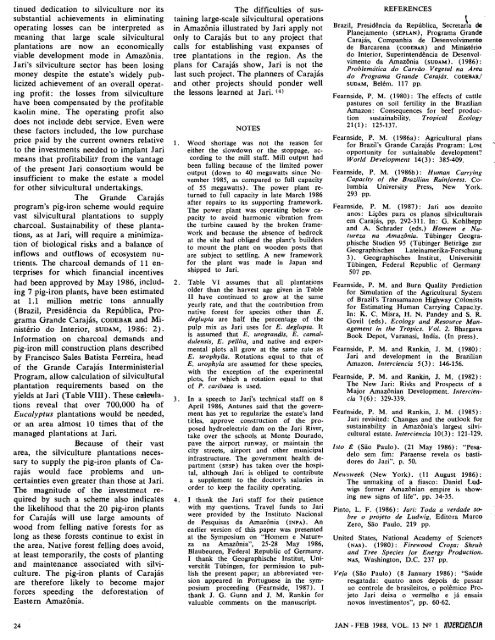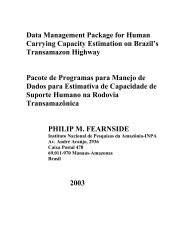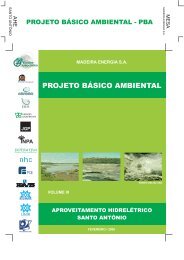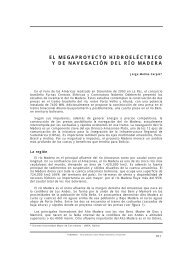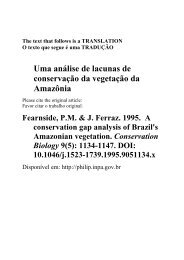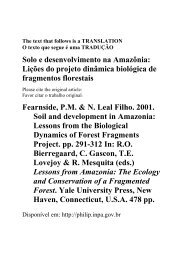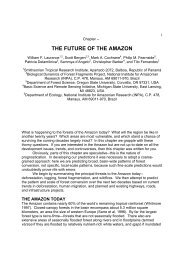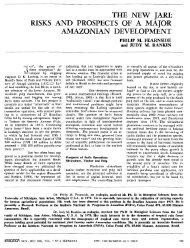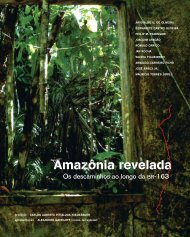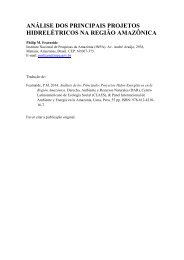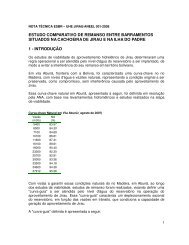jari at age 19 - Philip M. Fearnside - Inpa
jari at age 19 - Philip M. Fearnside - Inpa
jari at age 19 - Philip M. Fearnside - Inpa
Create successful ePaper yourself
Turn your PDF publications into a flip-book with our unique Google optimized e-Paper software.
tinued dedic<strong>at</strong>ion to silviculture nor itssubstantial achievements in elimin<strong>at</strong>ingoper<strong>at</strong>ing losses can be interpreted asmeaning th<strong>at</strong> large scale silviculturalplant<strong>at</strong>ions are now an economicallyviable development mode in Amaz6nia.J ari's silviculture sector has been losingmoney despite the est<strong>at</strong>e's widely publicizedachievement of an overall oper<strong>at</strong>ingprofit: the losses from silviculturehave been compens<strong>at</strong>ed by the profitablekaolin mine. The oper<strong>at</strong>ing profit alsodoes not include debt service. Even werethese factors included, the low purchaseprice paid by the current owners rel<strong>at</strong>iveto the investments needed to implant J arimeans th<strong>at</strong> profitabilitY from the vant<strong>age</strong>of the present J ari consortium would beinsufficient to make the est<strong>at</strong>e a modelfor other silvicultural undertakings.The Grande Carajasprogram's pig-iron scheme would requirevast silvicultural plant<strong>at</strong>ions to supplycharcoal. Sustainability of these plant<strong>at</strong>ions,as <strong>at</strong> Jari, will require a minimiz<strong>at</strong>ionof biological risks and a balance ofinflows and outflows of ecosystem nutrients.The charcoal demands of 11 enterprisesfor which financial incentiveshad been approved by May <strong>19</strong>86, including7 pig-iron plants, have been estim<strong>at</strong>ed<strong>at</strong> 1.1 million metric tons annually(Brazil, Presidencia da Republica, ProgramaGrande Carajas, cooEBAR and Ministeriodo Interior, suoAM, <strong>19</strong>86: 2).Inform<strong>at</strong>ion on charcoal demands andpig-iron mill construction plans describedby Francisco Sales B<strong>at</strong>ista Ferreira, headof the Grande Carajas InterministerialProgram, allow calcul<strong>at</strong>ion of silviculturalplant<strong>at</strong>ion requirements based on theyields <strong>at</strong> Jari (Table VIII). These ealetd<strong>at</strong>ionsreveal th<strong>at</strong> over 700,000 ha ofEucalyptus plant<strong>at</strong>ions would be needed,or an area almost 10 times th<strong>at</strong> of theman<strong>age</strong>d plant<strong>at</strong>ions <strong>at</strong> J ari.Because of their vastarea, the silviculture plant<strong>at</strong>ions necessaryto supply the pig-iron plants of CaraJaSwould face problems and uncertaintieseven gre<strong>at</strong>er than those <strong>at</strong> J ari.The magnitude of the investment requiredby such a scheme also indic<strong>at</strong>esthe likelihood th<strong>at</strong> the 20 pig-iron plantsfor Carajas will use large amounts ofwood from felling n<strong>at</strong>ive forests for aslong as these forests continue to exist inthe area. N<strong>at</strong>ive forest felling does avoid,<strong>at</strong> least temporarily, the costs of plantingand maintenance associ<strong>at</strong>ed with silviculture.The pig-iron plants of Carajasare therefore likely to become majorforces speeding the deforest<strong>at</strong>ion ofEastern Amazonia.The difficulties of sustaininglarge-scale silvicultural oper<strong>at</strong>ionsin Amaronia illustr<strong>at</strong>ed by Jari apply notonly to Carajas but to any project th<strong>at</strong>calls for establishing vast expanses oftree plant<strong>at</strong>ions in the region. As theplans for Carajas show, Jari is not thelast such project. The planners of Carajasand other projects should ponder wellthe lessons learned <strong>at</strong> Jari. < 4 >NOTES1. Wood short<strong>age</strong> was not the reason foreither the slowdown or the stopp<strong>age</strong>, accordingto the mill staff. Mill output hadbeen falling because of the limited poweroutput (down to 40 megaw<strong>at</strong>ts since No·vember <strong>19</strong>85, as compared to full capacityof 55 megaw<strong>at</strong>ts). The power plant returnedto full capacity in l<strong>at</strong>e March <strong>19</strong>86after repairs to its supporting framework.The power plant was oper<strong>at</strong>ing below capacityto avoid harmonic vibr<strong>at</strong>ion fromthe turbine caused by the broken frameworkand because the absence of bedrock<strong>at</strong> the site had obliged the plant's buildersto mount the plant on wooden posts th<strong>at</strong>are subject to settling. A new frameworkfor the plant was made in Japan andshipped to Jari.2. Table VI assumes th<strong>at</strong> all plant<strong>at</strong>ionsolder than the harvest <strong>age</strong> given in TableII have continued to grow <strong>at</strong> the sameyearly r<strong>at</strong>e, and th<strong>at</strong> the contribution fromn<strong>at</strong>ive forest for species other than E.deglupta are half the percent<strong>age</strong> of thepulp mix as Jari uses for E. deglupta. Itis assumed th<strong>at</strong> E. urograndis, E. camaldulensis,E. pe/lita, and n<strong>at</strong>ive and expermentalplots all grow <strong>at</strong> the same r<strong>at</strong>e asE. urophylla. Rot<strong>at</strong>ions equal to th<strong>at</strong> ofE. urophyla are assumed for these species,with the exception of the experimentalplots, for which a rot<strong>at</strong>ion equal to th<strong>at</strong>of P. caribaea is used.3. In a speech to Jari's technical staff on 8April <strong>19</strong>86, Antunes said th<strong>at</strong> the governmenthas yet to regularize the est<strong>at</strong>e's landtitles, approve construction of the proposedhydroelectric dam on the Jari River,take over the schools <strong>at</strong> Monte Dourado,pave the airport runway, or maintain thecity streets, airport and other municipalinfrastructure. The government health department(SESP) has taken over the hospital,although Jari is obliged to contributea supplement to the doctor's salaries inorder to keep the facility oper<strong>at</strong>ing.4. I thank the J ari staff for their p<strong>at</strong>iencewith my questions. Travel funds to Jariwere provided by the Instituto Nacionalde Pesquisas da Amazonia (INPA). Anearlier version of this paper was presented<strong>at</strong> the Symposium on "Homem e N<strong>at</strong>urezana Amazonia", 25-28 May <strong>19</strong>86,Blaubeuren, Federal Republic of Germany.I thank the Geographische lnstitut, UniversitiitTiibingen, for permission to publishthe present paper; an abbrevi<strong>at</strong>ed versionappeared in Portuguese in the symposiumproceeding (Fearn side, <strong>19</strong>87). Ithank J. G. Gunn and J. M. Rankin forvaluable comments on the manuscript.REFERENCESBrazil, Presidencia da Republica, Secretar\a dePlanejamento (SEPLAN), Programa GrandeCarajas, Companhia de Desenvolvimentode Barcarena (cooEBAR) and Mini.steriodo Interior, Superintendencia de Desenvolvimentoda Amazonia (suoAM). (<strong>19</strong>86):Problemdtica do Carviio Vegetal na Areado Programa Grande Carajds. CODEBAR/SUDAM, BeJem. 117 pp.<strong>Fearnside</strong>, P. M. (<strong>19</strong>80): The effects of c<strong>at</strong>tlepastures on soil fertility in the BrazilianAmazon: Consequences for beef productionsu;tainability. Tropical Ecology21(1): 125-137.<strong>Fearnside</strong>, P. M. ( <strong>19</strong>86a): Agricultural plansfor Brazil's Grande Carajas Program: Lostopportunity for sustainable development?World Development 14(3): 385-409.<strong>Fearnside</strong>, P. M. (<strong>19</strong>86b): Human CarryingCapacity of the Brazilian Rainforest. ColumbiaUniversity Press, New York.293 pp.<strong>Fearnside</strong>, P. M. (<strong>19</strong>87): Jari aos dezoitoanos: Lio;oes para os pianos silviculturaisem Carajas, pp. 292-311. In: G. Kohlheppand A. Schrader (eds.) Homem e N<strong>at</strong>urezana Amazonia. Tiibinger GeographischeStudien 95 (Tiibinger Betiriige zurGeographischen L<strong>at</strong>einamerika-Forschung3). Geographisches Institut, UniversitiitTiibingen, Federal Republic of Germany507 pp.<strong>Fearnside</strong>, P. M. and Burn Quality Predictionfor Simul<strong>at</strong>ion of the Agricultural Systemof Brazil's Transamazon Highway Colonistsfor Estim<strong>at</strong>ing Human Carrying Capac:ty.In: K. C. Misra, H. N. Pandey and S. R.Govil (eds). Ecology and Resource Man<strong>age</strong>mentin the Tropics. Vol. 2. BhargavaBook Depot, Varanasi, India. (In press).<strong>Fearnside</strong>, P. M. and Rankin, J. M. (<strong>19</strong>80):Jari and development in the BrazilianAmazon. Interciencia 5 (3): 146-156.<strong>Fearnside</strong>, P. M. and Rankin, J. M. (<strong>19</strong>82):The New Jari: Risks and Prospects of aMajor Amazonian Development. Interciencia7 (6): 329-339.<strong>Fearnside</strong>, P. M. and Rankin, J. M. (<strong>19</strong>85):J ari revisited: Changes and the outlook forsustainability in Amazonia's largest silviculturalest<strong>at</strong>e. Interciencia 10(3): 121-129.Isto E (Sao Paulo). (21 May <strong>19</strong>86): "Pesadelosem fim: Paraense revela os bastidoresdo Jari". p. 50.Newsweek (New York). (ll August <strong>19</strong>86):The unmaking of a fiasco: Daniel Ludwigsformer Amazonian empire is showingnew signs of life", pp. 34-35.Pinto, L. F. (<strong>19</strong>86): Jari: Toda a verdade sobreo projeto de Ludwig, Editora MarcoZero, Sao Paulo. 2<strong>19</strong> pp.United St<strong>at</strong>es, N<strong>at</strong>ional Academy of Sciences(NAS). (<strong>19</strong>80): Firewood Crops: Shruband Tree Species for Energy Production.NAS, Washington, D.C. 237 pp.Veja (Sao Paulo) (8 January <strong>19</strong>86): "Sauderesg<strong>at</strong>ada: qu<strong>at</strong>ro anos depois de passarao controle de brasileiros, o polemico ProjetoJ ari deixa o vermelho e ja ensaianovos investimentos", pp. 60-62.24JAN- FEB <strong>19</strong>88, VOL. 13 N


